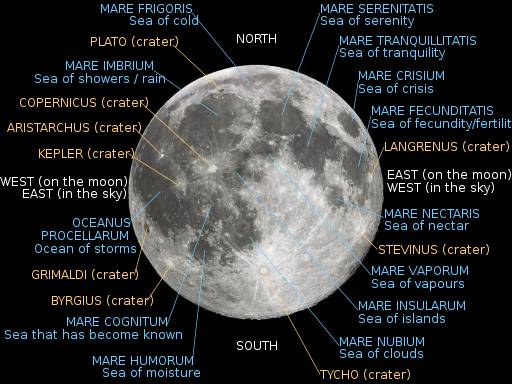 | THE LUNAR SURFACE |
This image is taken from http://en.wikipedia.org/wiki/File:Moon_names.svg |
My first student project (1971) included the exploration of lunar surface structures using the first cosmic images. Professor Katterfeld Gennady Nikolaevich was my patron.
The lunar surface has morphological elements of the first range (maria and terrae) and overlapping craters and lineaments.
Mares are flat plains that resulted from outpourings of fluid basaltic lavas. The dark maria makes up around 15% of Moons landscape and is concentrated on the visible side of the Moon.
Terrae is the light colored lunar highland elevated around several kilometers above the maria. Such topography dominates on the lunar surface and is the main feature on the backside of the Moon. Highlands are overlapped by craters. Today we know that terrae is composed from plutonic rocks that contain more that 90% plagioclase feldspar and rose like scum from a magma ocean in early phase of lunar history.
The most obvious features are ring structures and impact craters and craters within craters. In the case of impact craters, a meteorite with 3 meters in diameter can blast 150 m crater. The largest craters above 250 - 1000 km in diameter present a geological phenomenon that was common in the early history of the solar system and not common today. More than 4000 Ma, asteroids, having a big diameter, excavated several huge craters on the lunar surface. Because the crust was thinner and sufficiently fractured, magma began to bleed out. This lava welled up long after the craters formed.
We can organize classification of ring structures using different attributes (the size, structure genesis, relationship to topography, expressiveness on cosmic images, geometry and etc.), but two attributes are the most important: the size and genesis. For example, small craters are homogeneous and mostly occurred as a result of short-term one-act impact process. Craters with lava flow can give the evidence of volcanic activity.
We can outline five basic classes of crater sizes: mega, ìacro-, meso-, mini- and microstructures. Among of all ring structures, there are two genetical types: explosive and impact craters. Crater density on unit of a lunar surface is proportional to the age of this surface, so, using cosmic images, we can find the age of the Oceanus Procerrarum (Ocean of Storm), Mare Imbrium (Sea of Shower/Rain), Mare Nubium (Sea of Clouds); Mare Frigoris (Sea of Cold) and etc.
The lunar surface has small (less than 5-6 km) amplitude of elevation from the crater or maria lava floor. Mares and terraes include remnants of the older landscape (ridges, Montes Teneriffe, Spitsbergen, etc.) or tops (Mons Pico, Python). On the maria floor there are 2-4 lava flows of different age with overlapping each other. The several explosions can be shown on the front of the crater Tsiolkovsky on the backside of the Moon (Gorshkov, 1970). The Alpine valley and others were generated by a collapse of the lava channels. The major volcanic craters are located on the narrow sector of a longitude (Anaxagoras, Tycho, Kopernikus, Keplerus and Aristarchus).
The lunar surface keeps the huge opportunities for exploring processes in primaru crust ("the lunar stage) in which the Earth could be about 4000 Ìà. Moreover, using density of impact craters for planets of terrestrial group, it is possible to define relative ages of different structures and establish absolute age of a planet surface. For example, marine floor of Mars is younger than terrestrial topography. Being on the depth in 1-2 km below the average level of Mars, this floor is flat and has a small amount of good looking craters.
Katterfeld Gennady Nikolaevich
Katterfeld G. N. Areal and Time Distributions of Volcanic Formations on Mars
G. N. Katterfeld. Volcanism on Mercury
